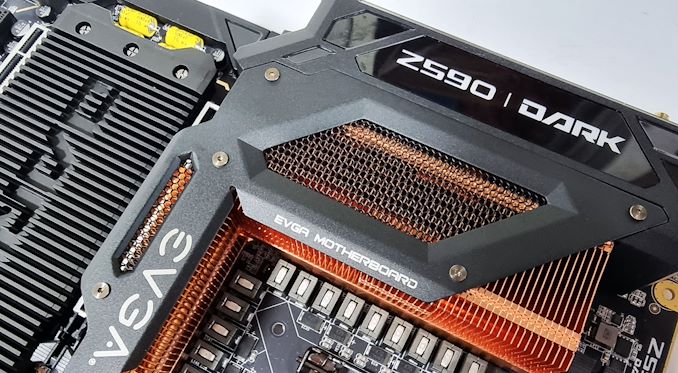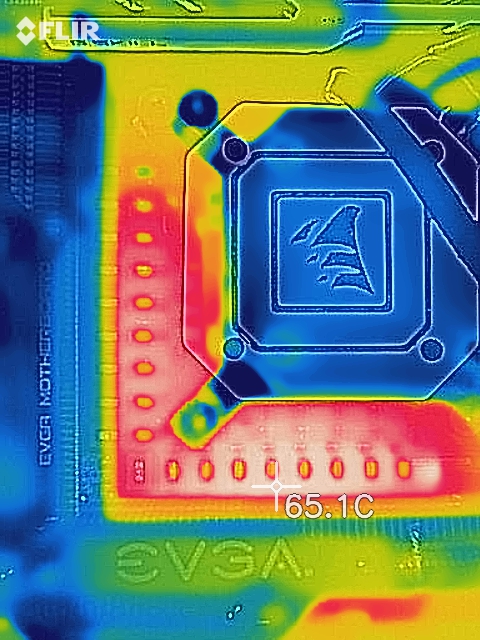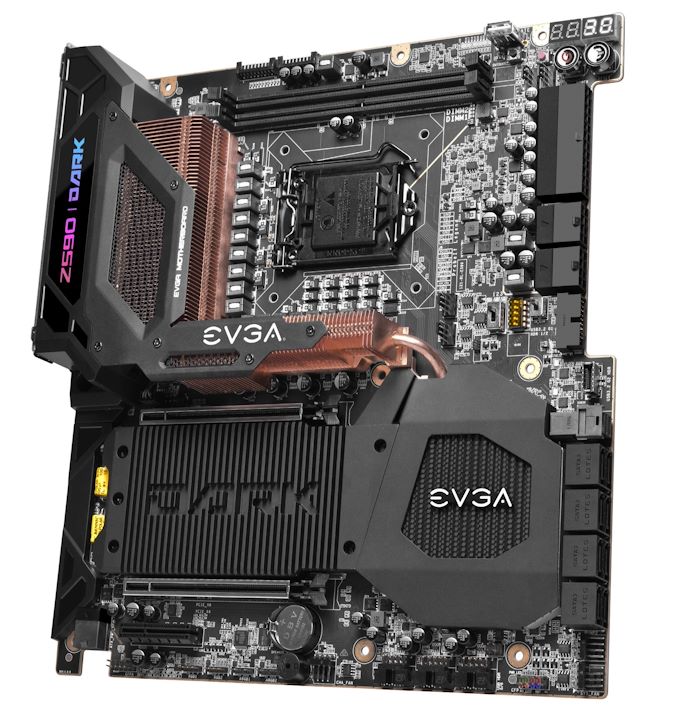The EVGA Z590 Dark Motherboard Review: For Extreme Enthusiasts
by Gavin Bonshor on October 15, 2021 9:00 AM EST
Getting the most out of Intel's Core i9-11900K primarily relies on two main factors: premium cooling for the chip itself, and a solid motherboard acting as the foundation. And while motherboard manufacturers such as EVGA can't do anything about the former, they have quite a bit of experience with the latter.
Today we're taking a look at EVGA's Z590 Dark motherboard, which is putting EVGA's experience to the test as one of a small handful of LGA1200 motherboards geared for extreme overclocking. A niche market within a niche market, few people really have the need (or the means) to overclock a processor within an inch of its life. But for those that do, EVGA has developed a well-earned reputation with its Dark series boards for pulling out all of the stops in helping overclockers get the most out of their chips. And even for the rest of us who will never see a Rocket Lake chip pass 6GHz, it's interesting to see just what it takes with regards to motherboard design and construction to get the job done.
EVGA Z590 Dark Overview
EVGA occupies an unusual spot within the wider motherboard market. The company has eschewed low-end and mid-range motherboards entirely, opting to focus on high-end boards. Case in point: of the handful motherboards they currently offer, the major of them are Dark boards aimed at extreme overclocking.
The end result is that while EVGA doesn't make (or sell) a lot of boards, what they do make stands out. And in the case of the Dark series (and thus the Z590 Dark) that starts with outright over-engineering motherboards in order to equip them with far more (or far higher grade) components than are actually needed. For a motherboard to operate within its parameters, such as Intel default settings on processors, they don't require things like ridiculously high phase counts to achieve this. But for extreme overclocking, it's another matter.
Some may say that overclocking isn't as popular as it once was, and to some degree that's true. Due to the advancements from both Intel and AMD on its methods and definitions of 'turbo' and 'boost,' it's not as fundamentally needed as it once was.
But don't tell the EVGA Z590 Dark that. Going so far as to support aggressive sub-ambient CPU cooling methods like liquid nitrogen (LN2) and dry ice (DICE), the EVGA Z590 Dark is a serious contender for those looking for maximum performance. An overclocker's toolkit is designed to make sub-zero overclocking more accessible, including dual Probelt voltage monitoring points and a dual two-digit LED debugger that can even read out current CPU VCore and temperatures.
It uses a transposed LGA1200 socket for better CPU pot mounting. Above the CPU socket is two horizontally mounted memory slots with support for DDR4-5333 out of the box and a maximum capacity of up to 64 GB, more than ample for anyone's desktop system. Other fanciful design traits include right-angled connectors, including the power connectors along the right-hand side, s |USB headers, and 4-pin fan headers.
With that said, not everything is aimed at overclocking, so the Z590 Dark includes a solid and fundamental feature set to boot. There's plenty of variety for storage with one PCIe 4.0 x4 M.2, one PCIe 3.0 x4 M.2, one PCIe 3.0 x4/SATA M.2, one rare PCIe 3.0 x4 U.2 slot, and eight SATA ports. Also present is a premium onboard audio solution and plenty of networking options with two 2.5 GbE controllers and an Intel Wi-Fi 6 CNVi. Other features include USB 3.2 G2x2 Type-C connectivity on the rear panel through native support on the Z590 chipset, while the Z590 Dark also has four USB 3.2 G2 Type-A ports.
Touching on the performance of the EVGA Z590 Dark in our testing, it showed that it's competitive with other Z590 boards we've tested. It's not as power-efficient as some other Z590 models, but we got good results in our POST time test, and it displayed incredible performance in our DPC latency testing. The performance in our compute and gaming benchmarks also shows the Dark is competitive with other models on test.

The EVGA Z590 Dark undergoing our VRM thermal testing
When it comes to overclocking, which the EVGA Z590 Dark is primarily designed for, we admittedly didn't see anything overly special compared to other Z590 boards – but then we "only" used a premium Corsair 360 mm AIO, rather than something more exotic. Still, the EVGA OC Robot utility built into the firmware was able to provide us with an impressive 5.4 GHz all-core stable overclock, but with a CPU VCore of 1.541 V and a whopping power draw of 497 W. Pragmatically, this overclock did run with a minus 3 offset on AVX workloads which meant it passed our POV-Ray benchmark. Still, we did see thermal throttling due to the insane amount of heat generated. Power delivery thermals were also respectable, but we would have liked to have seen better thermal performance than we got considering this board has an active cooling design.
Reflecting its high-end nature, the EVGA Z590 Dark carries a price tag of $599. And somewhat surprisingly, this isn't too outlandish for an enthusiast-grade overclocking motherboard in today's market, particularly when sizing up other high-end boards. Still, motherboards such as the MSI MEG Z590 Ace ($430) offer a much more comprehensive feature set with very competitive performance levels for users who aren't going to be applying dry ice to their CPUs. So where the Z590 Dark excels is going to be different from other high-end boards, and that's something that suits EVGA just fine.
Read on for our extended analysis.












27 Comments
View All Comments
Wrs - Monday, October 18, 2021 - link
AM4 isn't that bad. AMD has a ways to catch up to Intel in architecture & support, but the Zen 3 core is great, the CCD process node is world class, and PBO is effortlessly stable. As of April 2021 the USB issues are no longer. I specifically waited till then to buy a 5800x. That's 8C, 1 CCD, comparable to RKL but at half the power. You really don't need to upgrade BIOS/AGESA unless there are issues, or you're changing the CPU/OS. Haven't heard of AM4 specific PCIe issues (shoddy riser cables are a physical thing), and WHEA errors come from unstable all-core OCs or not taking a few hours to test and tune XMP RAM, seeing as XMP is tested on Intel platforms.That said, AM4 is nearing EOL as well, just 7 or 9 months later than Z590. I view performance as effectively a toss-up between the two, but that is a painful power delta over several years of ownership.
Silver5urfer - Monday, October 18, 2021 - link
Sorry you are wrong. I've seen people reporting USB issues on OCN, Reddit, NBR and other forums. All the issues are an inherent design flaw of Ryzen. This is AMD's specific first time come back so It's kinda expected. Nobody should push their IMC part 3600MHz of 1:1 FCLK.You are parroting April because that's the AGESA 1.2.0.2 fix which did not fix anything. I read already 70 pages of the thread on OCN about initial batch issues and the new thread as well regarding WHEA, as I said. Run Zen 3 on barebone stock or don't bother if you bother the CPU will glitch out with all the issues. Period. I'm a new buyer man what should I have even an incentive for looking for all these ? because I don't want to dabble in headaches on a DIY build.
Wrs - Tuesday, October 19, 2021 - link
Idk how else to tell ya this. I actually run a 5800x, it sits on a B550 board, there's 64 GB of RAM (4 sticks) at 3600 MHz, and Fclk is 1800 MHz aka 1:1 as listed on CPU-z. I do not get USB dropouts for my mouse, keyboard, external drive, or occasional printer or thumb drive. I don't get WHEA errors when I leave HWInfo running for a few days. My average uptime (wall clock time between reboots) is 8 days 14 hours. I haven't had a bluescreen since I gave up per-core undervolting.We're in agreement that people reported USB issues. That's why I waited before buying the 5800x. I do not know if it was a design flaw or configuration error or even if my specific system needed fixing, but with AGESA 1.2.0.1 Patch A back in April (my mobo maker listed USB connectivity among the release notes) I've never had the chance to experience USB dropouts.
danny11 - Monday, October 18, 2021 - link
Unfortunately TiN is retired from EVGA. He moved to US I guess due to family. Now those nice amazing articles on Xdevs are nowhere since Z490 series. <a href="www.abcd.com">abc</a>KennethHo - Saturday, February 19, 2022 - link
Is this not a weird MB?It's a massive E-ATX board, but only has 2 usable PCIe slots and 2 DIMM slots, for $600, with OK performance.
https://jaredspears.com/
ridnout - Monday, August 1, 2022 - link
That is to accommodate NVLink with 4-slot spacing because of the size of premium 30 Series Nvidia and 6000 series AMD offerings. Blower style fans are limited as per Nvidia, so adequate spacing for cards using NVLink (think SLI on steroids) is a must for cooling the hotter 3080/90 graphics cards. For machine learning, scientific computing, CAD, video editing, and host of other professional applications that can leverage NVLink, a linked pair of 3090 will markedly outperform on most tasks a an A6000 for a fraction of the cost. Remember, the consumer cards won't do high precision...limitations of the drivers.Just 2 cents.
haileynelson10 - Wednesday, April 13, 2022 - link
Appreciate detailed reviews for EVGA Z590 Dark Motherboard. I still have some doubts but this post solves it.https://findaword.co/